When a spinal disc degenerates, the soft gel inside the disc can seep into the spinal canal. This is known as a herniated disc or herniated disc..
The hernia is a consequence of the wear of the cover máexternal and hard s of the intervertebral disc, formágetting a crack in it, a través from which part of the soft internal content leaves the disk space.

Intervertebral hernia is a conditionón in which the central part of the intervertebral disc is compressed in the spinal canal
Once inside the spinal canal, the herniated disc exerts pressureón on the nerve, causing pain radiating down the nerve leading to the ciátick or legs (in case of a lumbar disc herniation) or on the arm (in case of a cervical disc herniation).
Index
¿Whaté it's a herniated disc?
There are many youédifferent terms that are used to describe the pathologyíto spinal disc and associated pain, What “herniated disc”, “pinched nerve” and “herniated disc”, and they are all used differently by the métips.
Unfortunately, health professionals are notáagree on a definitionón precise of any of these téterms, and patients can be frustrated when they learn that their diagnosisóStico refers to different téterms.
There is a variety of téinterchangeable terms (herniated disc, broken disk, herniated disc, cleverón discal, vertebral disc disease, black disc) which can add to the confusionón.
Instead of worrying about theéused rmino, it's meás úuseful for patients to gain an understandingóNo clear of diagnóstic méI say precise.
The diagnóstic méI say identifies the actual cause of the patient's back pain, pain in the legs and othersíntomas. The professional méphysician determines the cause of the patient's pain throughés de:
- Revisionón of history mépatient's doctor
- an exam fífull body
- One or más diagnostic testsósticas (if required)
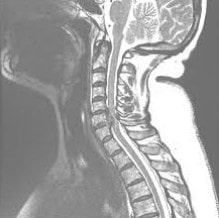 Disc herniation c5 c6
Disc herniation c5 c6
C5 C6 disc herniation is the rupture of the fibrous ring in the disc at the level of the fifth and sixth vértebras cervicales.
this thread (C5-C6) it is a very comfortable placeún pear la aparición of intervertebral hernia in the cervical spine. onceómain n of this apparitionón is aging, although in some cases, c5 c6 disc herniation may be due to trauma, intense exercise, a routine lifestyle, postures isátics, etc.
Sísymptoms of herniated disc C5 C6
Hernia in the C5-C6 segment is characterized by presenting the following symptoms:íntomas: weakness in the múdogs bíceps and musculoskeletal extensorsñeca. The pain, numbness and sensationón tingling may radiate to the hand.
The sísymptoms of a herniated disc C5 C6 alsoémay not include: pain, stiffness and limited mobility in the neck; así like headaches, dizziness and pressureón arterial alta.
 Hernia l5 S1
Hernia l5 S1
The dorsal hernia of the L5 S1 disc is a consequence of the degenerative processes of the spine (osteocondrosis). The hernias in this áspine area are quite common, because the regionón lumbosacral is under the greatest stressóit's not thereá in constant motion.
The l5 S1 hernia is known asúnly as dorsal or posterior hernia, because it goes back to the spinal canal. L5 S1 indicates the locationóexact number of the hernia, between the fifth vélumbar vertebra and the first vésacred bones.
This hernia is quite dangerous because it isá directed to the spinal canal and can giveñar the processes of the méspinal game, call “horse tail”, the consequences of which can be quite unpleasant.
Sísymptoms of dorsal disc herniation L5 S1
The first signíSingle of an l5 S1 hernia, located in the jointón lumbosacra, is the demonstrationón of pain in the lower back.
First, the pain occurs from an effort fíphysical intense, then by movements and twists of the body. In advanced cases, the sípain syndrome appears at rest.
This pain tends to increase with sudden movements, for example when coughing or bending or twisting the body. Discomfort may extend to the buttocks and sacrum. This is because the hernial bulge compresses the surrounding tissue and disrupts the anatóvertebral segment mica.
This causes a tensionón abnormal muscle, which extends to the side of the protrusión of the hernia or in the regionón lumbar.
If the hernia presses on the spinal nerve, the s appearíntomas neurológicos. I understood herón de la raíz nerve causes inflammationón in the áArea of hernia bulge and swellingóno soft tissue.
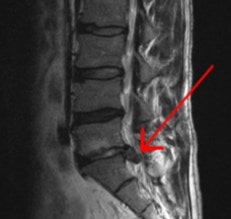 Hernia L4 L5
Hernia L4 L5
L4 disc herniation – L5 is comúcommonly known as lumbar hernia, because it occurs most often between the 4ª y 5ª vértebra. These two úlast discs of the lumbar spine stand out particularly, because it is this area the vertical load is carried, the push-ups and twists in the back. Therefore, there is a greater risk of hernia in this place..
Sísymptoms of lumbar disc herniation L4 – L5
He síntoma característic of a lumbar hernia is the ciática. With the thereática, the pain radiates from the waist down to one or both legs and sometimes, up to the feet. Back pain is often less pronounced than leg pain.
The pain más intense in the leg occurs when walking, stand or sit. Sometimes the pain comes withñnumbness and tingling pain in the leg or foot. Patients may experience muscle spasms in the back or leg.. Spaghettiéthey can't feel meúdogs déleg bills.
In severe cases, appears the paresis of the foot or the péloss of control over micción and defecationón.
Two causes of pain: pinched nerve vs disc pain
In the identificationóNo. of the cause of the patient's pain, There are two general types of spinal disc problems used by métips:
Pinched nerve
When a patient has a symptomatic herniated discática, the disc itselfí it is not painful, sino máit's alright the disc spilledándose, “pinching or prodding” a nerve.
This produces a pain called root pain, leading to pain that can be referred to other parts of the body, like those from the lower back to the leg, or from neck down to arm.
Leg pain from a pinched nerve is generally described as ciática.
This radicular pain is called a herniated disc.. Other common causes of a pinched nerve can include spinal stenosis and the spurs óspinal arthritis bone.
Disc pain
When a patient has a degenerated disc symptomático (causing back pain and / or leg pain), is the space that invades the disk itselfí, what is painful and the source of the pain. This type of pain is often called dolor axial.
Either of the above two conditions can occur in the cervical spine., torácica or lumbar. It tends to be más comúno in the lower back, because it is the area that carries the greatest load of weight and force in the día a día.
It must be taken into account that alléterms – herniated disc, pinched nerve, herniated disc, etc., refer to radiol findingsóobserved in a tomographíCT scan or MRIética.
While these results are important, are not as significant in determiningón of the cause of pain as the síspecific symptomsípatient records and exam results fíphysician of the méI say.
Black disc in the spine
The black disk is a pathologyíwhere does degeneration occurón of vertebral discs, where the nerve endings can extend to the núpulpy cleo and cause a lot of pain. It is given that name because in magnetic resonanceétic the hernia is observed as a black spot, since a degenerated disc contains less water.
Health professionals sometimes use different téterms to refer to pathologiesías associated with herniated discs. Black disc, torn disc, displaced disk, collapsed disk, protrusionón discal, disc disease and ruptured disc are some of the names used that can sometimes cause confusion.ón.
Diagnóstico of a herniated disc
a diagnosisóstic méI say (spaghettién known as a “diagnóstic clínico”) focuses on determinationón the cause of back pain, neck pain or otherísymptoms of a patient.
There are three steps to reach the diagnosisóstic clínico of a herniated disc:
- The exploración física. Depending on theípatient symptoms, the exam níphysical may include one or moreás of the following tests:
- The functionsón nervous in certain parts of the leg or arm, when testing on different áareas with a reflex hammer, having little or no reactionón is possibly indicative of a raícompressed nerve z. Sensory tests alsoécan not be carried out, using heat and coldíor to determine cóMo las raínervous breakdowns react to suchíin los.
- The muscular strength. In order to get a better understandingón if a raíz of spinal nerve está compressed by a herniated disc, the méI say probably performá a neurological examólogic to assess muscle strength. The méI say tambiéYou can ask the patient to undress so you can see the múdogs, especially if there is muscle atrophy, spasms or abnormal movements.
Pain with palpationónot the movement. Palpating certain structures can give an idea of what is reallyá generating pain. For instance:
- The joint painón sacroilíaca to the palpación may indicate that the patient has dysfunctionón in the jointón sacroilíaca.
- When it exists pain when straightening the leg may be indicative of a pinched nerve.
- The pain with pressureón on the lower back may indicate pain from a degenerated disc.
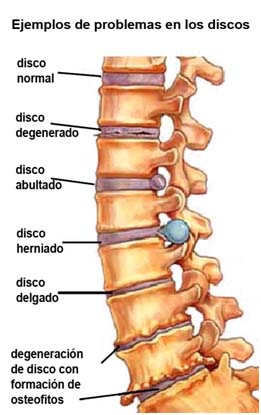
Revisionón of the síspecific symptomsíwe stay
A reviewócomplete n of the síntomas, includes the locationóno pain, a descriptionóno of cóhow does the pain feel, and if certain activities, positions or treatments make the pain feel better or worse.
Revisionón of history méI say
A history mécomplete dico is important to rule out (identify you) other possible conditions that may cause the patient's pain. The story includes informationón as recurring health problems, diagnóprevious sticos, treatments and surgeryíthe previous ones, even reactions to fármacos.
The exesáless than diagnóstico
afterés to form an opinionón about the cause of the patient's pain, a diagnostic test can be orderedóstic to confirm the spinal disc problem and/or to obtain informationóadditional n, like the locationón of herniated disc and raíincised nerve cessation.
The exesáless than diagnómay include:
TAC – Scannerícomputerized axial (TAC)
They work with X-rays, but with a computer you can edit the image in cross sections to get moreás spine detail.
Magn Resonance Imageética (IRM)
It allows the métell me an evaluationón sensitive and precise analysis of the nerves and anatomyíto the spine, including alignmentódisc no., the height, to hydrateón and configurationón.
MRI is not a diagnosisóstic méI say. The results of the tests on a magnetic resonance imageéethics or other exam are not in themselvesí themselves a diagnosisóstico that there is a herniated disc. Many people over 30 have someún level of disk problems, but few will haveáno pain associated with this.
In a nutshell, the examination findings n—íphysical of the patient and the sísymptoms have to match the MRI or other test findings to reach a diagnosisóstic méI say precise.
Sóit can then be prescribed a plan of effective treatment for the patient, as it involves the treatment of a nerve affected by a herniated disc, disc pain from degenerative disc disease, or some other conditionón.
Discogram
If surgery is consideredíto relieve disc pain, some méDoctors can recommend a record companyía in order to confirm the affected disk. In this test, a radiográfico is injected into the disk, with the belief that a patient isá suffering from disc pain (degenerative disc disease) if the injected contrast medium recreates normal pain. This test isémica as to whether or not it is a v testálida, exact, and many moreédicos do not use discographyía, except in exceptional situations.
Radiographería
At the radiographería does not reveal a herniated disc, Thus, not used for this diagnosisóstico. Nevertheless, to the radiographería can decipher other causes of pain, for example infections, tumors, growths óseos, dislocate usón vertebral or vertebral fractures.
Myelographía
in myelographyía coloring matter is introduced into the vertebral canal, to reveal the presence of herniated discs and other problems in the spinal canal. Nevertheless, the imágenes obtained are of low quality, onceón for which myelographyístop the diagnosisóStico of an intervertebral hernia is rarely used.
Electromiografía (EMG) and the study of drivingón nervous
These tests measure the strength of an impulse theénerve that transmits a particular nerve and help establish whenáhe of the nerves is givenñó what abouté place.
 Operationóherniated disc: risks
Operationóherniated disc: risks
There are many ways to remove a herniated disc, between them: láto be, extirpateón endoscópica and microquirúrgica. but alsoéthere are no other tétechniques where they are used méall modern níminimally invasive, including plasma nucleoplasty fríO, hydroplonic blockingástic and intraóseo.
La operationón to remove a herniated disc is aimed at correcting and restoring the núpulpal cleus that has been displaced from the intervertebral disc by rupture of the annulus fibrosus.
Even though the removalón of the hernia be ever más safe and less traumaáethics for the patient, there are risks. Let's see whaté it is about:
Surgery risksíherniated disc.
The consequences and complications afterés of any interventionón wantúsurgery to remove an intervertebral hernia are:
- Inflammationón of the injured disc
- infectionón
- Trauma every dayíz nervous
- Possible incontinence
- Risk of breakage of the méspinal cord and lesioníquido cefalorraquídeo
- Development of bleeding
Spaghettién there is a risk of the hernia recurring or developing in other parts of the spine. That's why I decidedón of a surgeryíshould be taken only afterés of a thorough examination of the patient.
Rehabilitationón lumbar disc herniation
afteréwith de la operationóno herniated disc, the patient must go through a período de rehabilitationón. The durationón de is períIt all depends on the characterícharacteristics of the patient and the severity of the disease (the tamañor hernia, you dry itón of the intervened vertebral column, etc.).
Durante la rehabilitationón can be applied méeveryone like:
- Therapy física
- Hirudotherapy (leeches treatment)
- shock wave therapy
- Acupuncture
- Therapy with theásee Magnético
- Electrostimulationón of the múspinal cords
The main objective of the rehabilitationón is to restore spinal mobility. the térehabilitation techniquesóthey should restore the functionón normal muscle and relieve pain. Además, during rehabilitationón, the general health of the patient is improved.
Lumbar disc herniation exercises
Exercises are required to strengthen the múback muscles, but before practicing these activities, consult your neurólogo and as soon as you can make them, you need to start.
Lumbar disc herniation exercises are performed lying down or on all fours. the positionón Standing or sitting is an additional burden and should not be done with a spinal hernia, since the vertical load can aggravate the situationón.
Spaghettién several m are includedéall self-stretching. For instance, can stretch the spine by hanging from a bar, the weight of the legs is enough to stretch the spine slowly.
Then, let's see nextón thaté exercises can and should be performed. not requireá andún additional equipment, except a rug.
Turning the knees
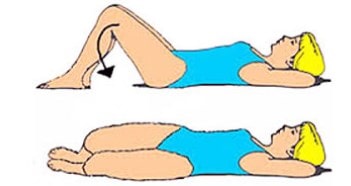
Lying on a rug on your back, hands behindás head and legs bent at the knees, forming a áangle of 90 degrees. Roll your knees to the side, up to a límite cóway.
Remain in this positionón lasting 5-10 seconds. We rise again to the positionóinitial n and we go down to the other side.
Keep your back straight. Raise your pelvis until a corner forms between your body and your legs.. Try not to lift your heels off the floor, so that the legs do not hang in the air. Repeat 10 times in each directionón.
Stretching and balancing

To perform this exercise we become 2 extremities: leg (knee) and arm on opposite sides of the body.
We start with the positionón of cat initially (on all fours). Stretch one leg backás and the opposite arm respectively, forward. Hold on for 10 seconds in this positionón and change the side. To repeat 5 times.
Arcoílaugh or cat exercise
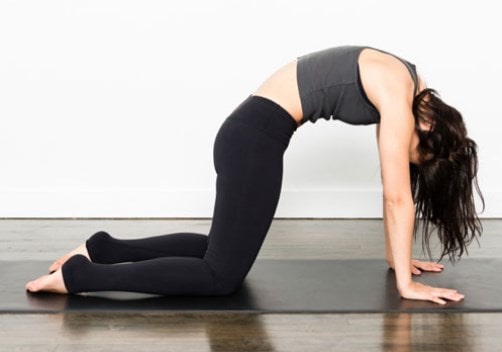
Párate on all fours, with straight head and hands. Palms should be pointing forward. Head down, while leaning your back up, until I get a positionóarc no., from head to tailbone.
Return back to the positionóinitial n slowly. We make 10 arc repeatsíris.
Exercises for the spine with a herniated lumbar disc are so diverse that it is más fáeasier to convey its principles than to list them all. We have explained only a smallñApart from all the existing options.
Lo más important is the gradual strengthening of the múdogs, so as not to have negative consequences. Consistency gives guaranteed results. If you consistently participate in a month, feel youáit's better.
5 thoughts on “Herniated disc or herniated disc”
Comments are closed.